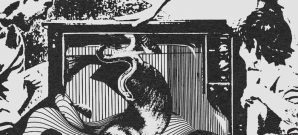 Although Brooklyn’s independent record label Captured Tracks has predominantly housed New York’s independent music scene over the past five years, CT recently took the initiative to expand internationally by adding Sweden’s post-punk outfit Holograms to the roster. The band released its self-titled debut album in 2012, which offered a hybridization of youthful raw punk and distortion, along with synth-heavy melodies. Since their first album’s release, however, the band has undergone tremendous growth, leading to the band’s sophomore release reflecting darker, colder themes.
Although Brooklyn’s independent record label Captured Tracks has predominantly housed New York’s independent music scene over the past five years, CT recently took the initiative to expand internationally by adding Sweden’s post-punk outfit Holograms to the roster. The band released its self-titled debut album in 2012, which offered a hybridization of youthful raw punk and distortion, along with synth-heavy melodies. Since their first album’s release, however, the band has undergone tremendous growth, leading to the band’s sophomore release reflecting darker, colder themes.
The band member’s personal lives between the two albums played a large part in the creative process on Forever. The decision to embark on an international tour left them jobless, and along the tour, the members faced several difficulties they were not expecting, such as robbery and poverty. Additionally, once the adrenaline rush of touring ended, the members were forced to returning to their sleepy, isolated homes: Stockholm for brothers Anton (vocals/guitar) and Filip Spetze (synth) and the nearby Farsta for Andreas Lagerström (vocals/bass) and Anton Strandberg (drums). In the midst of their bleakness, the band members’ reservoir of untapped creative energy fermented into a desire longing for musical experimentation, creating the themes of resent against the boredom of life through post-punk sound.
Before listening to the LP, the theme of darkness can be experienced in the album’s artwork itself. Although some artists find album art as unnecessary (see Yeezus) or a thoughtless last minute add-on, Forever’s image perfectly reflects the album’s overarching sound. The image draws from William-Adolphe Bougeureau’s 1850 painting ‘Dante and Virgil In Hell’, which features grisly violent image of a damned soul devouring its victim while the legendary writers watch in the background. The album art features the scene’s two souls sans the original painting’s background, instead drowning the imagery in a pitch-black wall. Upon viewing such a scene, one cannot help but instinctively withdraw, at least momentarily, at the sensation bleakness that will be further filled-in by auditory fashion.
In its hopes to capture a church-like sound, Holograms distanced themselves the silver lining melodies, instead favoring heavier, hollow sounds and sorrowful, deprecating lyrics. On “Ättestupa”, the industrial guitar sound consistently swoops in, a caustic tone riding above the heavy bass line looming in the background. “I’m so tired,” Lagerström bemoans repetitively, emphasizing the song’s sense of fatigue with life. Unsuspectingly, a discordant synth suddenly drags the listener down further into the psychologically opaqueness, adding sand to the mind’s sleepy eye. The album’s single “Flesh and Bone” furthers the theme of discontent; a metallic rhythm caters the sensation of grueling working class labor supplied by “Fire and coal / Flesh and bone.”
Holograms, however, has not ditched all of its old ways. Shockingly, opening track “Rush” harkens to the fast picking guitar riffs, energetic drum beats, and high-pitched synth melodies heard on tracks like “Chasing My Mind”. Similar, the driven, aggressive rhythm guitar entry on “A Blaze On the Hillside” perfectly adds to Lagerström’s blood-curling battle cry lyrics. The energy that the listeners draw from the track is enough to instill a burning desire to mosh alone in their rooms, yet not feel ridiculous for doing so.
While Holograms seems to have improved by firmly cementing the band’s genre with Forever, this action ended up hindering the band’s sound and musical appeal. One of the better features about Holograms was the raw and unsure aspects of the album’s sound, like the scrawny punk who tries to stand his ground but winds up with a smashed in face. Even though few claim uncertainty as a positive, Holograms translates that insecurity into the violent, youthful edge that goes perfectly with distorted and lo-fi melodies. On Forever, however, a definite genre sands down the raw patches that they have tried to retain. Lagerström apathetically shouts the lyrics, “When sweat turns into ice / We suffer, we painted Christ,” on “Wolves”, but the vocals don’t impact the listener with a sensation of pain or suffering. Instead, it seems more plausible to imagine this as the background music of Scandinavian Viking on a triumphant voyage home from a battle.
Although Holograms didn’t nail the album shut with perfection, the band is still young. Their youth and inexperience, which benefited them by their ability to capture its essence on their first album, proved to be their downfall on their second album by a young band’s mistake to push too far. Hopefully they still carry the same burning sensation to create and experiment that they did going when beginning to record, and will give us something to look forward to on the next album.


















